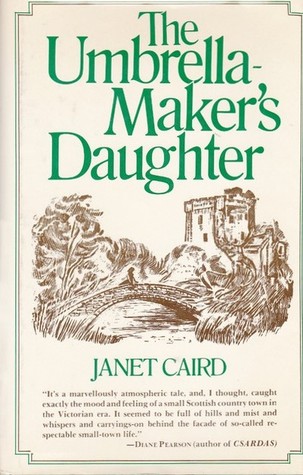
In 1832 Mary Tullis and her father, the umbrella-maker, arrive from Glasgow to make a new life in the Scottish town of Dyplin. It will be a hard year for the townsfolk: cholera comes, so do the resurrectionists stealing bodies from their graves. The new young minister is profoundly tested as he falls under the spell of the attractive newcomer. Meg Annan, of the stained reputation, is also in love. But much of the love — and the hate — is misplaced, culminating in the May Burning, in which the tensions of the community are tragically released.
The Umbrella-Maker’s Daughter is the kind of book you happen upon at a yard sale or thrift store that convinces you you’ve found a lost classic. While the synopsis leads one to expect a vaguely gothic historical romance, the book reads more like an early Victorian Winesburg, Ohio by way of Glasgow. Like Winesburg, Ohio, The Umbrella-Maker’s Daughter is less about the titular characters than about Dyplin itself. It’s a chilling study of the personality of a small town, as singular and alive as its inhabitants. Dyplin serves as a cult-like figurehead, incorporating and indoctrinating those who dwell there into its activities and traditions.
Yet it wasn’t Winesburg, Ohio that came to mind first when I read The Umbrella-Maker’s Daughter, but another largely-forgotten book, Wisconsin Death Trip, a non-fiction account of small town life in Wisconsin in the late 19th century formed by newspaper clippings and photographs. Wisconsin Death Trip, in keeping with its ghastly title and histrionic prose of the author, is a catalog of the commonplace ephemera of 19th century that modern readers find justifiably grotesque: post-mortem photography, mementos mori, accounts of sudden attacks of madness, wild superstitions accepted as fact, and whole households succumbing to mysterious illnesses.
Janet Caird presents a similar catalog of morbidity in The Umbrella-Maker’s Daughter, but keeps it from becoming the W.S. Walcott Medicine Show with her lucid, matter-of-fact prose. Her only weak spot is the Scottish dialect used in dialogue; like the exaggerated Southern and hillbilly dialects of Erskine Caldwell, it nearly pushes her highlanders into caricature. For the reader who is not an historian of the wonderfully oddball ephemera of the 19th century, this use of dialect can push the strange traditions and legends of Dyplin too far into the “other” to be truly horrifying.
When you find a buried treasure like The Umbrella-Maker’s Daughter, your first assumption is that you’ve rediscovered a criminally neglected author. Alas, like Dyplin, The Umbrella-Maker’s Daughter is singular in Janet Caird’s bibliography; while Caird wrote a number of other books during the 1960s-70s, most seem to be minor crime and suspense entries.